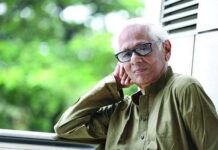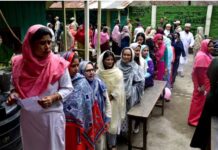Shahid Islam

Perhaps a book – writing may not suffice to explain fully how Bangladesh had descended into a ‘kingdom of fear.’ Most affected are the youths aged between 15-35, who constitute about 60 per cent of the total population and, many of whom had become jihadists over the years, according to police and other security forces. It’s been a decade of turbulence since the last BNP regime left power to a caretaker regime in late 2006.
What we witness today have long been in the making, and expected. In the summer of 2006, Bangladesh was equally busy in an internal anti-terror sweep against some revolutionary Islamic zealots determined to retaliate following the arrest of a top militant leader, Siddiqul Islam, of a banned Islamic group, the Jagrata Muslim Janata Bangladesh (JMJB), which, along with Jamayetul Mujahideen Bangladesh (JMB), has been waging a bloody campaign for the imposition of Islamic laws in the country.
Ten years on
Ten years on, the same battles are being fought by the country’s security forces with the Islamic fighters who had, in years since, established a global connection with the IS and the al-Qaeda and have started using sophisticated weapons and methods in attacks launched by educated youths abandoning families to wage a jihad against what they consider as ‘the secular, subdued, state apparatuses run by the incumbent AL-led regime.’
In recent history, massive islamization of the Bangladeshi society had occurred prior and after the division of India in 1947. In the late 1980s, president Ershad even inscribed Islam as the state religion of the country in the constitution. Yet, so severe was the drive to secularize the Muslim-predominant Bangladesh in the last decade that the young fighters of today are hell bent on turning the country into a truly Islamic nation, according to the principles and the objectives laid out in various jihadi literatures.
This massive transformation of the society did not occur in a vacuum. To be honest, the military intervention in January 2007 occurred under a grand global scheme to stem the tide of Islamic revivalism in South Asia and, the US envoy to Dhaka, Patricia A Butenis, was briefed by a designated officer of the Bangladesh army about why the army decided to step into the political muddle.
Some of the factual narratives of the 2007 military intervention appear in the whistle-blowing website WikiLeaks, which had disclosed the developments described by the US embassy in Dhaka in a cable sent to Washington on January 12, 2007. According to that diplomatic cable, the reports were composed and sent by Patricia A Butenis, then US ambassador in Bangladesh, to Washington elaborating the 1/11 events.
State of hopelessness
The leaked documents revealed that “Brig Gen Amin of the DGFI claimed that the military’s moves were motivated by three factors – the UN statements that military participation in a one-sided election could jeopardise its participation in the peacekeeping operations; concern over renewed threats from Jama’atul Mujahideen Bangladesh (JMB) to thwart the election; and, continuing Awami League protests and planned actions against elections.”
If 2006 was a year of uncertainty, 2016 is of total hopelessness. In 2006, the country had a legal framework enshrined in the constitution how to handle the crisis. The caretaker system was in vogue; the military didn’t have the agony of having lost fellow officers in dozens in the BDR mutiny that followed in 2009. Above all, the then political regime in power, the BNP-Jamat compact, had the valid mandate to govern and facilitate the power transition by virtue of being a representational government elected by popular votes.
Today, the Islamists are more organized, armed and determined to die in their missions, but the government battling them is bereft of legality due to its resumption of power through an election in which majority of law makers were elected unopposed due to abstention from 2014 election of major opposition parties, including the BNP. Worst still, the parliament has an official opposition party, the JP, which is also part of the government, and, quite incredulously, has representations in the cabinet too.
All of the above derailments had happened in the midst of a political climate fraught with arbitrariness, arrogance, and a determined effort to exclude all dissenters from the political process.
Price of authoritarianism
This authoritarian dispensation had so far managed to digest the 2009 BDR mutiny; the brutal assault on unarmed Hefajat activists in 2013 and banning of Jamat from participating in elections while being a legally-registered political party; arrest and prosecution-persecution of thousands of BNP-Jamat leaders and activists; murder of hundreds in so called gun battle and cross fire, and, trial- prosecution of BNP leader Khaleda Zia and her son Tariq Rahman. In the meanwhile, the entire Jamat team had dashed to the underground, especially since the 2014 election, to avoid mass arrest and cross-fire executions.
Today, the global observers of Bangladesh politics by and large are unanimous that the crisis of legitimacy and governance, coupled with scorch earth measures against dissenters and the mass media, had convinced many educated youths of affluent families to join the global jihadists due to the country having no credible elections and leadership grooming methods, and, the sovereignty having been compromised with India by allowing unfettered access inside Bangladesh of Indian transports, as well as bilateral measures taken to harm local markets, environment, energy distribution and natural resources. The Rampal coal-driven power plant construction near the world heritage site in Sundorbon is just one of such examples.
According to William B. Milam, a former U.S. ambassador to Bangladesh and Pakistan, “the recent string of vicious killings in Bangladesh is less a terrorism issue than a governance issue: It is the ruling Awami League’s onslaught against its political opponents, which began in earnest after the last election in January 2014, that has unleashed extremists in Bangladesh.”
So far, the government didn’t agree to that hypothesis. Resultantly, the city of Dhaka had witnessed and experienced the worst since the July 1 attack on Gulshan’s Holey Artisan bakery by fighters indisputably aligned with and carrying the IS banner. According to a number of intelligence agencies and political observers watching closely Bangladesh’s drift to anarchy, over 3,500 ISIL fighters of Bangladeshi origin are still active within Bangladesh to conduct similar attacks inside the country, and elsewhere in South Asia.
National Security Council (NSC)
And, given the depth of destruction, damage and horror such attacks can unleash, does Bangladesh have the elasticity to allow the crisis prolong further at a time when most of the foreigners are folding tails to leave the country and the buyers and investors from abroad are cancelling scheduled visits to the country on security ground. Even the British Council in Dhaka has closed its operations on feared security risks.
May be its time the framework for a National Security Council (NSC) is prepared to enable it to stay standby in case the crisis becomes unmanageable. This is an urgent undertaking in light of the political leaders’ unwillingness to sit together, and the danger of external intervention increasing by the day as more and more localities of Dhaka and other cities are found to have been infested by Islamic fighters.
Last but not the least, the more time we take to realize the evolving reality, the more the nation will slide further downward, as has been observed since the coming to power of the AL regime in early 2009. Looking back, one also observes how the AL’s promise of gifting eggs to the nation had vanished in a whisk with the slaughtering of the very goose that lay such golden eggs. Who will disagree that the existence of Bangladesh as a sovereign nation is at stake now.
Source: Weekly Holiday










Very bold in what the writer just said in the last line.
Expect flaks coming at you.